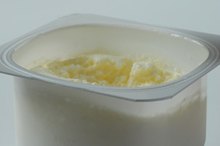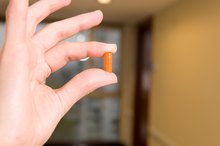Foods That Lower Alkaline Phosphatase
Enzymes are accelerants, proteins that facilitate biochemical reactions without being chemically modified themselves. For example, every second, one single solitary molecule of the enzyme carbonic anhydrase causes a million molecules of carbon dioxide to bind with H2O, thus moving carbon dioxide out of the bloodstream. Alkaline phosphatase is an enzyme, too, found throughout the body catalyzing many different kinds of reactions.
Isoenzymes
While alkaline phosphatase occurs throughout the body, it is found primarily in the liver, bone, placenta and intestine. These organs each produce a different variant of the enzyme alkaline phosphatase and these are called isoenzymes. They have the same function as the parent enzyme but slightly different molecular structures. The respective activity levels of the isoenzymes can be measured independently. They are useful indicators in the clinical diagnosis of a host of illnesses.
- While alkaline phosphatase occurs throughout the body, it is found primarily in the liver, bone, placenta and intestine.
- The respective activity levels of the isoenzymes can be measured independently.
Causes of High Alkaline Phosphatase Levels
What Foods Raise Alkaline Phosphatase Levels?
Learn More
Alkaline phosphatase levels could rise quite normally. Any sort of bone growth will elevate alkaline phosphatase levels as per normal childhood development or the healing of a bone break. During pregnancy, alkaline phosphatase produced by the placenta leaks into the mother’s bloodstream, incurring a normal, expected rise in the enzymatic level.
Conversely, illnesses can contribute to elevated alkaline phosphatase levels. These illnesses include but are not limited to Paget’s disease, known colloquially as rickets, germ cell tumors, inflammatory bowel disease, cholestatic-liver disease (where the liver bile ducts are blocked), among many others.
- Alkaline phosphatase levels could rise quite normally.
- Any sort of bone growth will elevate alkaline phosphatase levels as per normal childhood development or the healing of a bone break.
Causes of Low Alkaline Phosphatase Levels
For adults, a normal alkaline phosphatase serum concentration range is 1.5 to 4.5 Bodansky units. If a patient presents with a decreased level of alkaline phosphatase, any of the following conditions may be implicated: zinc deficiency; hypothyroidism; vitamin C deficiency; vitamin B6 deficiency; folic acid deficiency; excess vitamin D intake; low phosphorous levels; Celiac disease; low protein assimilation; low parathyroid gland function; pernicious anemia.
The Vitamin D Connection
Causes of High Blood Levels of Vitamin B12
Learn More
High alkaline phosphatase levels can lead to secondary ills but these levels can be countermanded. As per the study, “Hypovitaminosis D and Elevated Serum Alkaline Phosphatase in Elderly Irish People” conducted by The American Society for Clinical Nutrition, “the effect of vitamin D status on alkaline phosphatase is clearly demonstrated for the first time 1. The age-related elevation of alkaline phosphatase is tempered by vitamin D repletion.”
Vitamin D can be absorbed directly from plentiful sunlight or obtained from dietary intake and where there is sun-deprivation, then from dietary intake alone. The study concludes, “The value of increased vitamin D intake, either by direct supplementation or augmented fortification of food stuffs with vitamin D is manifest. 1”
- High alkaline phosphatase levels can lead to secondary ills but these levels can be countermanded.
- As per the study, “Hypovitaminosis D and Elevated Serum Alkaline Phosphatase in Elderly Irish People” conducted by The American Society for Clinical Nutrition, “the effect of vitamin D status on alkaline phosphatase is clearly demonstrated for the first time 1.
Food Choices
Per 100 grams edible portion, the richest sources of vitamin D can be found in fish oils 1. While 100 grams of dry nonfat milk provides 440 IUs of vitamin D, and 100 grams of dried shittake mushrooms provides 1660 IUs of vitamin D, 100 grams of Halibut liver oil delivers 368,000 IUs of vitamin D; mackerel oil?130,000 IUs of D; Rockfish liver oil?97,800 IUs of D; Swordfish liver oil?130,000 IUs of D; Tuna Liver Oil?130,000 IUs of D; cod liver oil (medicinal, regular)?16,700 IUs of D. Fish (fillet, raw) and related products provide an average IU-yield of 450 IUs per 100 grams edible portion. All other food choices lag distantly behind.
Related Articles
References
- U.S. Department of Agriculture, Agricultural Research Service. "Provisional Table on the Vitamin D Content of Foods"; Human Nutrition Information Service. HNIS/PT108.
- Li D, Lv H, Hao X, Hu B, Song Y. Prognostic value of serum alkaline phosphatase in the survival of prostate cancer: evidence from a meta-analysis. Cancer Manag Res. 2018;10:3125-3139. doi:10.2147/CMAR.S174237
- Siddique A, Kowdley KV. Approach to a patient with elevated serum alkaline phosphatase. Clin Liver Dis. 2012;16(2):199-229. doi:10.1016/j.cld.2012.03.012
- Kumar: Robbins and Cotran: Pathologic Basis of Disease, 7th ed.
Writer Bio
Dana Rausch has worked for 20 years in the legal and financial industries as a proofreader and copy editor. Rausch previously wrote dance criticism for the "Rhode Island Review." She holds a Bachelor of Arts in English and American literature from Brown University.









